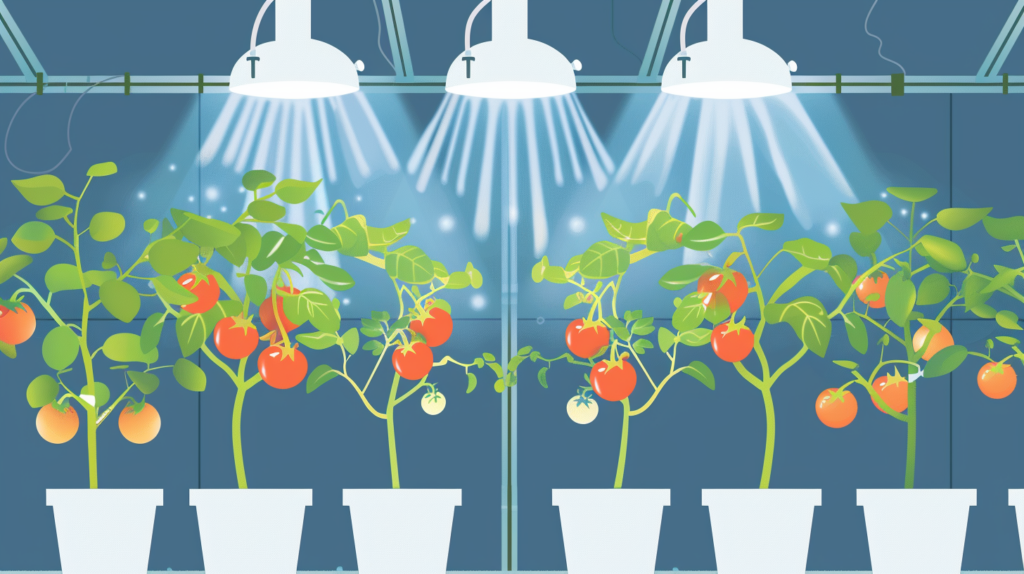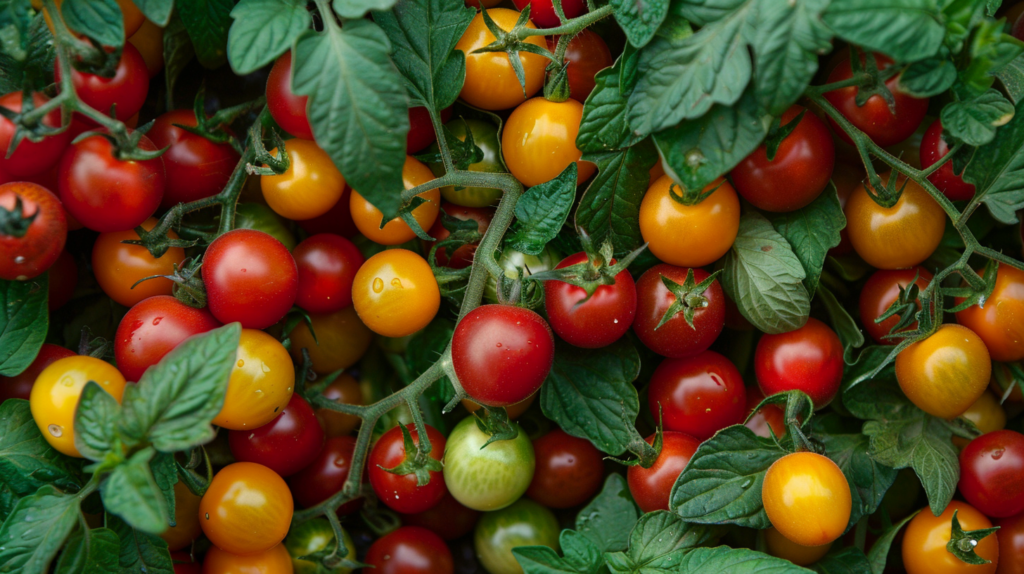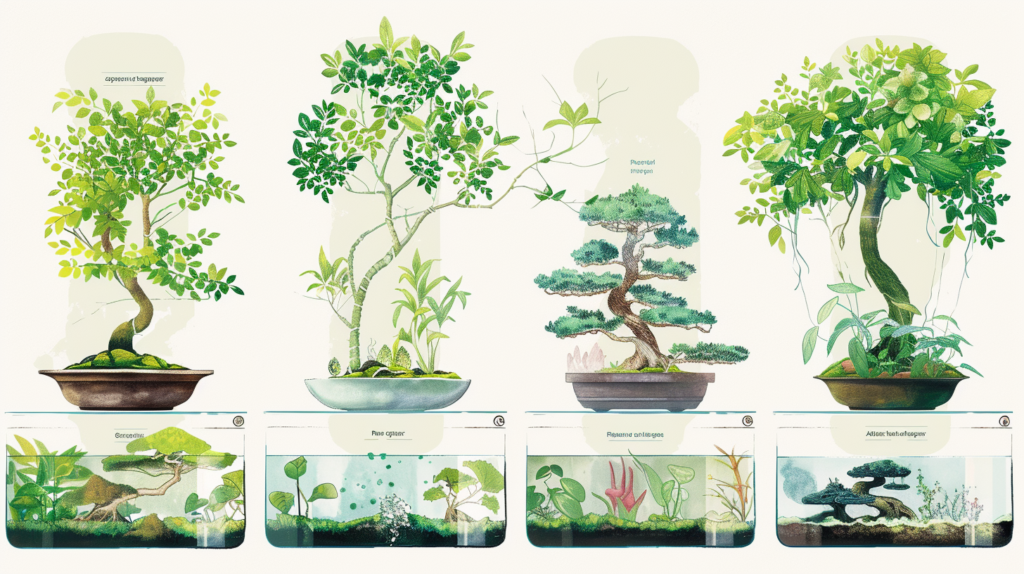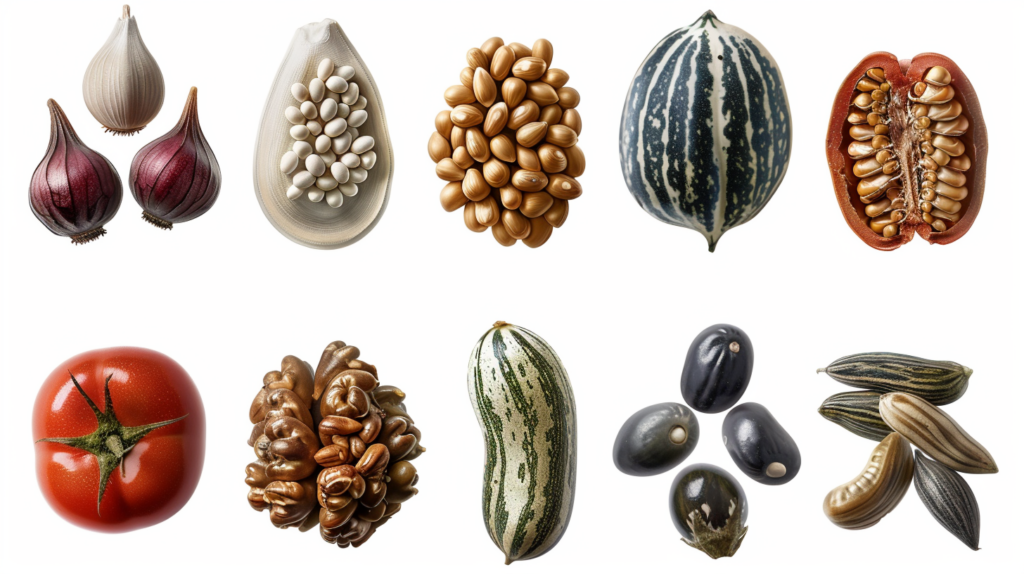Introduction
Growing cherry tomatoes hydroponically offers numerous advantages, including higher yields, better flavor, and year-round production. This indoor gardening method allows you to cultivate delicious cherry tomatoes without soil, using nutrient-rich water solutions. In this article, I’ll share five essential tips to help you succeed in hydroponic cherry tomato cultivation. From selecting the right system and varieties to optimizing nutrient levels and providing ideal growing conditions, these strategies will ensure a bountiful harvest of juicy, flavorful cherry tomatoes right in your own home or greenhouse.
The benefits of growing cherry tomatoes hydroponically

Growing cherry tomatoes hydroponically offers several compelling benefits that make it an attractive choice for home gardeners and commercial growers alike.
Firstly, hydroponic systems allow for precise control over the nutrient solution, ensuring that the plants receive an optimal balance of essential minerals and nutrients. This results in faster growth rates, higher yields, and more flavorful fruits compared to traditional soil-based cultivation. Another significant advantage of hydroponic cherry tomato growing is the ability to produce crops year-round, regardless of outdoor weather conditions or seasonal changes. By creating a controlled indoor environment, you can maintain ideal temperatures, humidity levels, and lighting conditions, enabling consistent and reliable tomato production throughout the year.
Additionally, hydroponic systems are space-efficient, making them suitable for urban gardening or areas with limited outdoor space. Vertical growing techniques and stackable systems maximize the use of available space, allowing for higher plant density and increased yields per square foot. Furthermore, hydroponic cultivation reduces the risk of soil-borne diseases and pests, as the plants are grown in a sterile environment without soil. This not only promotes healthier plant growth but also minimizes the need for pesticides, making hydroponic cherry tomatoes an environmentally friendly and sustainable choice.
Finally, hydroponic systems are water-efficient, as the nutrient solution is recirculated and reused, reducing water consumption compared to traditional agriculture methods. This water conservation aspect is particularly beneficial in areas with limited water resources or during periods of drought.
Overview of the 5 tips for successful hydroponic cherry tomato cultivation

To ensure a successful hydroponic cherry tomato cultivation, this article will provide five essential tips.
First, we’ll explore the different hydroponic systems available and guide you in selecting the most suitable one for your cherry tomato plants. Next, we’ll discuss the importance of choosing the right cherry tomato varieties that thrive in hydroponic environments. Maintaining proper nutrient balance and pH levels is crucial, so we’ll cover strategies to optimize these factors. Additionally, we’ll delve into the lighting and temperature requirements for optimal growth and fruit production.
Finally, we’ll share effective pruning and training techniques tailored specifically for hydroponic cherry tomato plants.
Explanation of different hydroponic systems (ebb and flow, nutrient film technique, deep water culture)

When it comes to hydroponic systems for growing cherry tomatoes, there are several options to consider, each with its own unique features and benefits.
The ebb and flow system, also known as flood and drain, involves periodically flooding the grow tray with nutrient solution and then draining it back into the reservoir. This cyclical process ensures that the plant roots receive adequate moisture and nutrients while preventing waterlogging.
The nutrient film technique (NFT) is another popular hydroponic method. In this system, a shallow stream of nutrient-rich water continuously flows through grow channels, providing a constant supply of moisture and nutrients to the plant roots. NFT systems are known for their efficient use of water and nutrients, making them a suitable choice for cherry tomato cultivation.
Deep water culture (DWC) is a simple yet effective hydroponic system that involves suspending the plant roots directly in a nutrient solution. An air stone or air pump is used to oxygenate the water, ensuring that the roots receive adequate oxygen for healthy growth. DWC systems are easy to set up and maintain, making them a great option for beginners or those with limited space. Another popular choice is the drip system, which involves a network of tubing that delivers a slow and steady supply of nutrient solution directly to the plant roots. This method is highly efficient in terms of water and nutrient usage, and it can be easily automated for hands-off operation.
Lastly, the aeroponic system is a unique approach that involves suspending the plant roots in an enclosed chamber and periodically misting them with a nutrient-rich solution. This method provides excellent oxygenation and nutrient delivery, resulting in rapid growth and high yields. However, aeroponic systems tend to be more complex and expensive compared to other hydroponic methods.
Factors to consider when selecting a system for cherry tomatoes

When selecting a hydroponic system for growing cherry tomatoes, several factors should be taken into consideration. Space availability is a crucial aspect, as some systems like deep water culture or ebb and flow may require more horizontal space, while nutrient film technique or aeroponic systems can be more vertically oriented.
Additionally, the level of maintenance and monitoring required for each system should be evaluated based on your time and expertise. Systems like drip or aeroponic may demand more frequent monitoring and adjustments compared to deep water culture. The initial investment and ongoing operational costs are also important factors to consider, as some systems may require more expensive equipment or higher energy consumption. Furthermore, the scalability of the system should be assessed if you plan to expand your cherry tomato production in the future.
Finally, personal preferences, such as the desired level of automation or the ability to move the system, can influence your choice of hydroponic system.
Recommended cherry tomato varieties for hydroponic growing

When it comes to hydroponic cherry tomato cultivation, selecting the right varieties can make a significant difference in your success. Some recommended varieties that thrive in hydroponic systems include Tiny Tim, Sweet Million, Sweetie, and Red Robin. These compact, indeterminate varieties are known for their prolific fruit production and excellent flavor.
Another excellent choice is the Suncherry Premium variety, which produces large, sweet cherry tomatoes with a vibrant red color. This variety is highly resistant to common tomato diseases, making it well-suited for hydroponic growing. For those seeking a unique flavor profile, the Black Cherry tomato is a great option. Its deep purple-black color and rich, complex taste make it a standout among cherry tomato varieties. If you prefer a larger cherry tomato size, consider the Supersweet 100 or the Rapunzel varieties.
These indeterminate plants produce an abundance of sweet, juicy fruits that can reach up to 1.5 inches in diameter. For those interested in growing yellow or orange cherry tomatoes, the Goldita and Sungold varieties are excellent choices. They offer a delightful burst of flavor and add a pop of color to your hydroponic garden. When selecting cherry tomato varieties for hydroponic growing, it’s also important to consider factors such as disease resistance, fruit size, and plant vigor to ensure optimal performance in your chosen hydroponic system.
Characteristics to look for in hydroponic-friendly tomato varieties

When choosing cherry tomato varieties for hydroponic growing, there are several key characteristics to look for.
Firstly, consider varieties with a compact or determinate growth habit, as these plants tend to be more manageable in the confined spaces of hydroponic systems.
Additionally, seek out varieties that are specifically bred or recommended for hydroponic cultivation, as they are often more resilient and productive in soilless environments. Disease resistance is another important factor, as hydroponic systems can be susceptible to certain pathogens if not properly maintained. Look for varieties that are resistant to common tomato diseases like fusarium wilt, verticillium wilt, and early blight.
Furthermore, pay attention to the fruit size and yield potential of the variety. While cherry tomatoes are generally smaller than their larger counterparts, some varieties produce more abundant or larger fruits, which can impact your overall yield.
Finally, consider the flavor profile and intended use of the cherry tomatoes. Some varieties are bred for exceptional sweetness, while others offer a more balanced or tangy taste, allowing you to choose the perfect variety for your culinary preferences.
Importance of proper nutrient balance for tomato plant growth
Maintaining a proper nutrient balance is crucial for successful hydroponic cherry tomato cultivation. Tomato plants require a specific combination of essential nutrients to thrive, and any deficiency or excess can have detrimental effects on their growth and fruit production. Nitrogen, phosphorus, and potassium are the primary macronutrients that play vital roles in plant development. Nitrogen is essential for leaf growth and overall plant vigor, while phosphorus supports root development, flowering, and fruit formation. Potassium, on the other hand, enhances disease resistance, water regulation, and fruit quality.
In addition to these macronutrients, tomato plants also require various micronutrients, such as calcium, magnesium, iron, boron, and zinc. These micronutrients are involved in various physiological processes, including enzyme activation, chlorophyll production, and cell wall formation. An imbalance in any of these nutrients can lead to various issues. For instance, a nitrogen deficiency can cause stunted growth and yellowing of leaves, while an excess can result in excessive foliage growth at the expense of fruit production.
Similarly, a lack of calcium can lead to blossom end rot, a common problem in tomato cultivation. By carefully monitoring and adjusting the nutrient solution in your hydroponic system, you can ensure that your cherry tomato plants receive the optimal balance of nutrients required for healthy growth, abundant flowering, and bountiful fruit production.
Guidelines for maintaining ideal pH levels in hydroponic systems
Maintaining the ideal pH level in your hydroponic system is crucial for ensuring optimal nutrient uptake and plant health. For cherry tomatoes, the recommended pH range is between 5.5 and 6.5. A pH level outside this range can lead to nutrient deficiencies or toxicities, stunting plant growth and reducing yields. To maintain the desired pH level, regular monitoring and adjustments are necessary. You can use pH test kits or digital meters to accurately measure the pH of your nutrient solution. If the pH is too high, you can lower it by adding a pH-down solution or a mild acid like phosphoric acid.
Conversely, if the pH is too low, you can raise it by adding a pH-up solution or a mild base like potassium hydroxide. It’s important to make small incremental adjustments and retest the pH after each addition to avoid overshooting the desired range. Additionally, certain nutrients can influence the pH level, so it’s essential to maintain a balanced nutrient solution to minimize pH fluctuations.
Lighting requirements for cherry tomatoes (intensity, duration, and spectrum)

Providing adequate lighting is crucial for successful hydroponic cherry tomato cultivation. Tomato plants require a specific intensity, duration, and spectrum of light to thrive and produce abundant fruit. In terms of intensity, cherry tomatoes generally require between 6,000 and 10,000 lux (600 to 1,000 foot-candles) of light.
This level of intensity can be achieved through a combination of natural sunlight and supplemental grow lights, such as high-intensity discharge (HID) or LED lights. Regarding duration, cherry tomatoes need at least 12 to 16 hours of light per day during the vegetative growth stage and up to 18 hours during the flowering and fruiting stages. Consistent light exposure is essential for optimal plant development and fruit production. The light spectrum is also an important consideration. Tomato plants require a balanced spectrum that includes both blue and red wavelengths. Blue light promotes healthy vegetative growth, while red light encourages flowering and fruit development.
Many specialized grow lights are designed to provide the ideal light spectrum for tomato plants, ensuring optimal growth and yield. It’s important to monitor and adjust the lighting conditions as your cherry tomato plants progress through different growth stages. By providing the right intensity, duration, and spectrum of light, you can maximize your hydroponic cherry tomato yields and enjoy a bountiful harvest of flavorful, nutrient-dense fruits.
Optimal temperature range for hydroponic cherry tomato growth

Cherry tomatoes grown hydroponically thrive best within a specific temperature range. During the day, the optimal temperature for vegetative growth and fruit production is between 70°F and 85°F (21°C to 29°C). At night, slightly cooler temperatures around 65°F to 70°F (18°C to 21°C) are ideal.
Maintaining consistent temperatures within this range is crucial, as fluctuations can stress the plants and negatively impact their growth and yield. Proper temperature control through heating or cooling systems, insulation, and ventilation is essential for successful hydroponic cherry tomato cultivation.
Pruning methods to promote better fruit production

Implementing proper pruning techniques is essential for promoting better fruit production in hydroponic cherry tomato plants. One effective method is the Missouri pruning technique, which involves removing all suckers (side shoots) below the first flower cluster. This technique encourages the plant to direct its energy towards fruit development rather than excessive foliage growth.
Another popular pruning method is the Dutch bucket system, where the main stem is allowed to grow, and all suckers are removed as they appear. This method maximizes the plant’s potential for fruit production while maintaining a manageable size. For indeterminate cherry tomato varieties, which continue to grow and produce fruit throughout the season, a combination of pruning techniques can be employed. This includes removing suckers below the first flower cluster and periodically pruning off the oldest, least productive stems to encourage new growth and fruit set. It’s also important to prune off any diseased, damaged, or yellowing leaves and stems to maintain plant health and prevent the spread of pathogens.
Additionally, removing any excess foliage that blocks light from reaching the fruit clusters can improve air circulation and prevent fungal diseases. Consistent and timely pruning not only promotes better fruit production but also helps to maintain a well-structured plant, allowing for easier access to the fruits during harvesting and better overall plant management in the hydroponic system.
Training techniques (trellising, caging) for hydroponic cherry tomato plants

Training techniques such as trellising and caging are essential for hydroponic cherry tomato plants to ensure proper support, air circulation, and light exposure. Trellising involves using a vertical support system, such as a stake, cage, or trellis, to guide the plant’s growth upward. This technique not only maximizes the use of vertical space but also improves air circulation and light penetration, leading to better fruit production. Caging is another popular training method, where a wire or plastic cage is placed around the plant, providing support and allowing the stems and branches to grow through the openings.
This technique is particularly useful for indeterminate cherry tomato varieties, which can grow quite tall and require sturdy support. Both trellising and caging help to keep the plant upright, preventing it from sprawling or becoming tangled, which can lead to disease and pest issues. Additionally, these training techniques make it easier to access the fruits during harvesting and facilitate better air circulation, reducing the risk of fungal diseases.
Recap of the 5 tips for successful hydroponic cherry tomato cultivation
In this article, we’ve explored five essential tips for successful hydroponic cherry tomato cultivation.
First, we discussed the importance of selecting the right hydroponic system that suits your space, budget, and maintenance preferences. Next, we highlighted the need to choose cherry tomato varieties specifically suited for hydroponic growing, considering factors like disease resistance, fruit size, and flavor. Maintaining proper nutrient balance and pH levels in the hydroponic system was emphasized as crucial for optimal plant growth and fruit production. We also covered the lighting and temperature requirements for cherry tomatoes, ensuring they receive the right intensity, duration, and spectrum of light, as well as the ideal temperature range.
Finally, we explored effective pruning and training techniques, such as the Missouri and Dutch bucket methods, as well as trellising and caging, to promote better fruit production, air circulation, and light exposure. By implementing these five tips, you’ll be well on your way to cultivating a bountiful harvest of delicious, homegrown cherry tomatoes in your hydroponic garden.
Encouragement to try hydroponic gardening and enjoy fresh, homegrown cherry tomatoes
Hydroponic gardening offers an exciting opportunity to grow fresh, flavorful cherry tomatoes right in your own home or greenhouse. By following the tips outlined in this article, you can unlock the potential of this sustainable and space-efficient gardening method. Embrace the joy of nurturing your hydroponic cherry tomato plants and witnessing their growth from seedlings to bountiful fruiting vines. Savor the unmatched taste of homegrown, vine-ripened cherry tomatoes, bursting with flavor and nutrients. Embark on this rewarding journey and experience the satisfaction of harvesting your own delicious, hydroponic cherry tomato crop.



